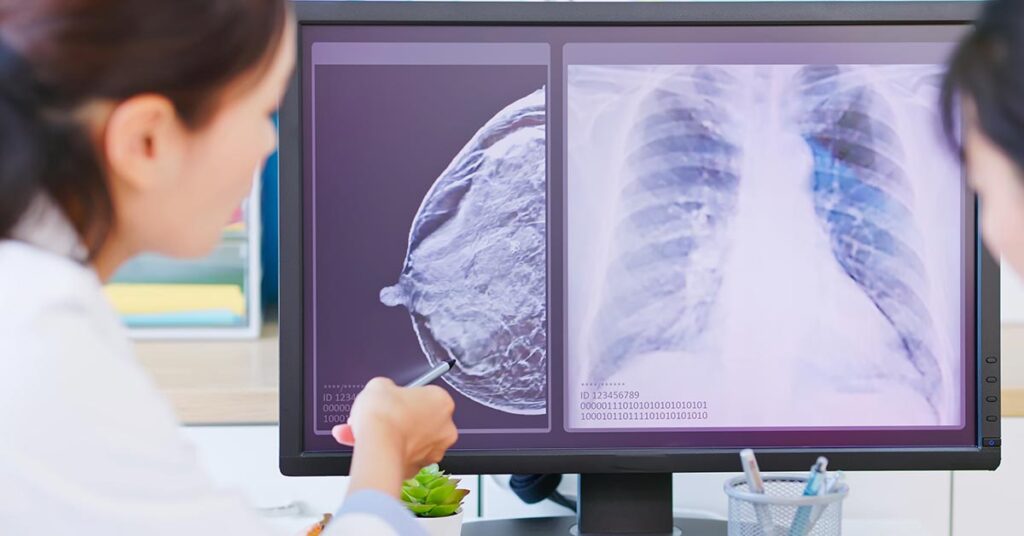Learn more about breast cancer, the most common cancer among Singaporean women and a reliable way of breast cancer screening in Singapore: mammography.
What Is Breast Cancer?

Breast cancer is an uncontrolled division and growth of breast cells, which might sometimes invade surrounding tissue. The growth of the cancer may be very slow in some cases, and faster in other cases. They often start in the ducts while some might start in the milk sacs or lobes.
Mortality Rate For Breast Cancer In Singapore
According to the Singapore Cancer Registry Annual Report 2019, breast cancer is the most common cancer among females in Singapore, accounting for 29.4% (11,805 incidences) of all cancers for women diagnosed from 2015 to 2019. It is also the most common cause of cancer deaths for females in Singapore, accounting for 17.1% (2,208 deaths) of female cancer deaths from 2015 to 2019.
Breast cancer is more prevalent among Indian females than among Chinese and Malay females, with it being 35.7% of all cancer diagnoses (for Indian females) in 2015-2019. For the 40-49 year old age group, breast cancer comprised 46.8% of all cancers diagnosed among women in Singapore (2015-2019).
Is Breast Cancer Treatable?
While the incidence rate of breast cancer is high, the breast cancer survival rate in Singapore had increased over the years with improved treatments. The five-year Age-Standardised Relative Survival rate (ASRS) for breast cancer in Singaporean women improved from 49.9% in 1973-1977 to 82.1% in 2015-2019. Women should carry out DIY breast self-examinations and undergo regular breast cancer screening for early detection of potential cancerous growths.
Symptoms of Breast Cancer
During the early stages, breast cancer may have no symptoms at all. However, once the cancer becomes more advanced, the following symptoms of breast cancer may be noticed:
- A persistent lump or thickening in the breast or armpit area.
- A newly retracted nipple.
- A change in the colour or skin of the breast, areola or nipple.
- Bloody nipple discharge.
- A change in the size or shape of the breast.
Who Should Consider Breast Cancer Screening (Mammography)?
| Age | Frequency |
| 40 to 49 years old | Once a year |
| 50 years old and above | Every 2 years |
Get Screened For Breast Cancer With Mammography
Mammography is today the most reliable way of breast cancer screening in Singapore.
A mammogram screening is a specialized medical imaging procedure that is designed to examine the breast tissue for any sign of abnormalities, particularly those that may indicate breast cancer. There are two main types of mammograms: 2D and 3D mammograms. They are typically done in the same way, but the difference between 2D and 3D mammograms lies in the way the breast images are captured and presented.
2D Mammogram (Conventional Mammogram)
In a 2D mammogram, two X-ray images are taken of each breast: the top-to-bottom view and the side view. These 2D or two-dimensional images provide a flat representation of the breast tissue.
3D Mammogram (Tomosynthesis)
3D mammography or also known as tomosynthesis, takes multiple X-ray images of the breast from various angles. These images are then reconstructed into a 3D image, providing a series of thin slices or “layers” of the breast tissue. It provides a more detailed and comprehensive view of the breast compared to 2D mammogram.
As breast cancer risk increases with age, women aged 50 and above should consider undergoing mammogram screening once every 2 years.
Mammography Packages From Our Partners
Health365 in partnership with trusted medical providers offers mammography screening packages on our e-commerce platform.

DIY Breast Self-Examination
In addition to mammography where in situations where it is recommended, women are encouraged to also perform DIY breast self-examinations monthly. The Singapore Cancer Society suggests a simple 3-step procedure:
Step 1: Look
Put your hands on your hips and look out for changes in breast shape, skin surface and nipple abnormalities. Raise your arms above your head to look for changes (especially dimples) on the underside of your breast.
Step 2: Touch
Touch and feel your breast using your middle 3 fingers, moving in a circular motion from outer area towards the nipple. Gently squeeze your nipple to check for any discharge.
Repeat this step for your other breast
Step 3: Check
Check for lumps by examining your entire breast from your armpit to your cleavage with different pressure.
Repeat this step for your other breast.
Learn More About Breast Cancer
Read more about breast cancer on health365.sg.
